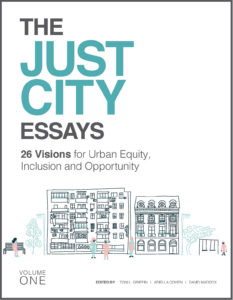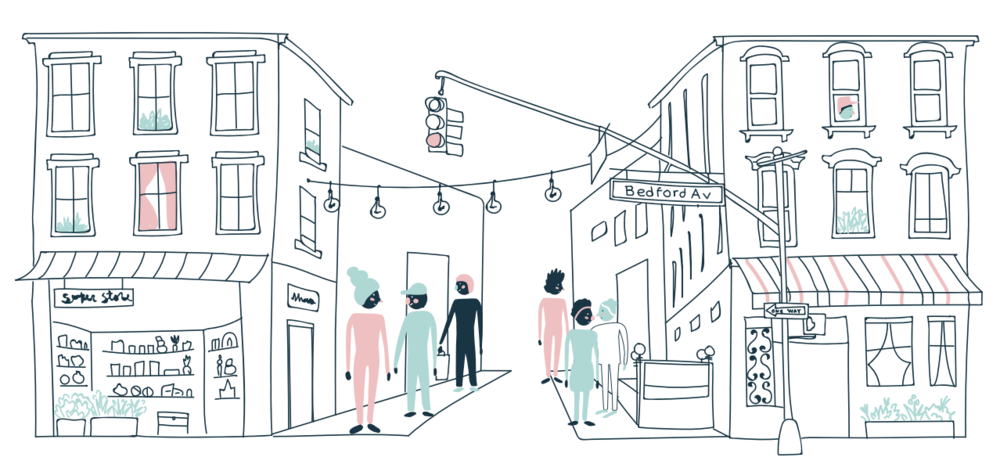“Five years ago, the Harvard Graduate School of Design’s Just City Lab published The Just City Essays: 26 Visions of Inclusion, Equity and Opportunity. The questions it posed were deceptively simple: What would a just city look like? And what could be the strategies to get there? These questions were posed to mayors, architects, artists, philanthropists, educators and journalists in 22 cities, who told stories of global injustice and their dreams for reparative and restorative justice in the city.
 These essays were meant as a provocation, a call to action. Now, during these times of dissonance, unrest, and uncertainty, their contents have become ever more important. For the next 26 weeks [starting June 15, 2020], the GSD and the Just City Lab will republish one essay a week here and at designforthejustcity.org. We hope they may continue conversations of our shared responsibility for the just city.
These essays were meant as a provocation, a call to action. Now, during these times of dissonance, unrest, and uncertainty, their contents have become ever more important. For the next 26 weeks [starting June 15, 2020], the GSD and the Just City Lab will republish one essay a week here and at designforthejustcity.org. We hope they may continue conversations of our shared responsibility for the just city.
We believe design can repair injustice. We believe design must restore justice, especially that produced by its own hand. We believe in justice for Black Americans. We believe in justice for all marginalized people. We believe in a Just City.”
—Toni L. Griffin, Professor in Practice of Urban Planning, founder of the Just City Lab, and editor of The Just City Essays
Urban Spaces and the Mattering of Black Lives
By Darnell L. Moore
It was close to midnight. A youngish, jovial-looking white woman with russet colored hair ran by me with ostensive ease. She donned earphones and dark, body-fitting jogging attire. I was walking home from the A train stop and along Lewis Avenue, which is a moderately busy thoroughfare that runs through the BedfordStuyvesant neighborhood in central Brooklyn, where I live.
Lewis runs parallel to Marcus Garvey. Black. Two avenues to the right is Malcolm X Boulevard. It’s Black. Fulton Street. Atlantic Avenue. The B15 bus. Bedford Avenue. Marcy Projects. Brownstoners. The C train. Working class renters. Peaches Restaurant. June Jordan. Livery taxis. Restoration Plaza. Jay-Z. Bed-Stuy is quite black. I am, too.
Encountering the strange sight of a white woman running without care on a street in a section of our borough once considered an unredeemable “hood” terrified me. She ran past the new eateries and grocery shops that sell organic and specialty foods. Within a span of a few blocks, residents and visitors now have their choice of premium Mexican eats, brick oven pizza or freshly baked scones with artisanal coffee. Citi Bike racks and skateboard-riding hipsters adorn the now buzzing thoroughfare. To many, our part of Bed-Stuy may appear safer, cleaner, and whiter.
And yet, I was still terrified. It was midnight. Black boys and men have been killed throughout the history of the U.S. for being less close to and observant of white women’s bodies as I was that late evening.
Shortly after I passed by the white woman jogger, my close friend, Marcus, who lives within walking distance from me—closer to a densely populated public housing development—lamented lingering tremors of gentrification. Citing the presumed changes in racial demographics, renovated housing options and increased business development efforts, Marcus hinted at the frustration of black communities undergoing rapid and contested transformation.
He came upon a flier that was fastened to a tree. According to Marcus, the New York Police Department precinct near his building created a “wanted” sign that was posted not too far from where he lived. The “wanted” were a few black men who allegedly robbed a neighbor. The neighbor was white.
Never before, in the several years Marcus had lived in Bed-Stuy, had he seen anything similar. There were no signs made after black teens were shot or robbed. There were no cries for the “wanted” after black women and girls were sexually assaulted or followed home by a predator. There was no indication of concern for black people besides the ever-present anxiety black bodies seem to cause both to the state and to white people when they dwell en masse in the hood. A cursory review of NYPD’s data on the disproportionate and deleterious impact of stop, question and frisk procedures and broken windows policing on black communities is but one example. Marcus’s critique resonated because it illuminated the ways the state and its citizenry afford value to white lives.
Hence, the reason for selecting the vignettes I’ve opened with here. In both scenes, white bodies signify worth and, therefore, are always centered in our collective imagination. They are esteemed commodities, especially in black spaces—that is, neighborhoods and other publics mostly inhabited and culturally shaped by a majority black populace. Thus, any dreamed and invented “just city” that is structured by a set of race ideologies that do not factor in the hyper-mattering of white lives and the perceived worthlessness of black and brown lives is not “just” at all. That is why catch phrases such as “community development” or “urban planning and design” can be counterproductive if, in fact, one’s praxis is not guided by a commitment to a type of transformative work grounded in the belief that black lives actually matter. Continue reading on designforthejustcity.org…
